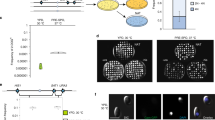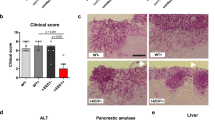Abstract
Candida albicans, the most prevalent human fungal pathogen, is considered to be an obligate diploid that carries recessive lethal mutations throughout the genome. Here we demonstrate that C. albicans has a viable haploid state that can be derived from diploid cells under in vitro and in vivo conditions, and that seems to arise through a concerted chromosome loss mechanism. Haploids undergo morphogenetic changes like those of diploids, including the yeast–hyphal transition, chlamydospore formation and a white-opaque switch that facilitates mating. Haploid opaque cells of opposite mating type mate efficiently to regenerate the diploid form, restoring heterozygosity and fitness. Homozygous diploids arise spontaneously by auto-diploidization, and both haploids and auto-diploids show a similar reduction in fitness, in vitro and in vivo, relative to heterozygous diploids, indicating that homozygous cell types are transient in mixed populations. Finally, we constructed stable haploid strains with multiple auxotrophies that will facilitate molecular and genetic analyses of this important pathogen.
This is a preview of subscription content, access via your institution
Access options
Subscribe to this journal
Receive 51 print issues and online access
$199.00 per year
only $3.90 per issue
Buy this article
- Purchase on Springer Link
- Instant access to full article PDF
Prices may be subject to local taxes which are calculated during checkout




Similar content being viewed by others
Change history
18 November 2015
Nature 494, 55–59 (2013); doi: 10.1038/nature11865 In this Article, there were two errors in allele assignments. In the legend and colour key to Fig. 1b, the allele identity (‘a’ and ‘b’) is inadvertently reversed. Figure 1 of this Corrigendum shows the corrected panel b and legend for the original Fig.
References
van der Walt, J. P. Sexually active strains of Candida albicans and Cryptococcus albidus . Antonie van Leeuwenhoek 33, 246–256 (1967)
Sarachek, A., Rhoads, D. D. & Schwarzhoff, R. H. Hybridization of Candida albicans through fusion of protoplasts. Arch. Microbiol. 129, 1–8 (1981)
Suzuki, T., Nishibayashi, S., Kuroiwa, T., Kanbe, T. & Tanaka, K. Variance of ploidy in Candida albicans . J. Bacteriol. 152, 893–896 (1982)
Olaiya, A. F. & Sogin, S. J. Ploidy determination of Candida albicans . J. Bacteriol. 140, 1043–1049 (1979)
Riggsby, W. S., Torres-Bauza, L. J., Wills, J. W. & Townes, T. M. DNA content, kinetic complexity, and the ploidy question in Candida albicans . Mol. Cell. Biol. 2, 853–862 (1982)
Kelly, R., Miller, S. M., Kurtz, M. B. & Kirsch, D. R. Directed mutagenesis in Candida albicans: one-step gene disruption to isolate ura3 mutants. Mol. Cell. Biol. 7, 199–208 (1987)
Kurtz, M. B. & Marrinan, J. Isolation of hem3 mutants from Candida albicans by sequential gene disruption. Mol. Gen. Genet. 217, 47–52 (1989)
Magee, P. T., Kakar, S. & Kwon-Chung, K. in Genetic Analysis of Candida albicans by Complementation (ed. Schessinger, D. M. ) 230–233 (American Society of Microbiology, 1983)
Whelan, W. L., Partridge, R. M. & Magee, P. T. Heterozygosity and segregation in Candida albicans . Mol. Gen. Genet. 180, 107–113 (1980)
Jones, T. et al. The diploid genome sequence of Candida albicans . Proc. Natl Acad. Sci. USA 101, 7329–7334 (2004)
Gräser, Y. et al. Molecular markers reveal that population structure of the human pathogen Candida albicans exhibits both clonality and recombination. Proc. Natl Acad. Sci. USA 93, 12473–12477 (1996)
Bougnoux, M.-E. et al. Mating is rare within as well as between clades of the human pathogen Candida albicans . Fungal Genet. Biol. 45, 221–231 (2008)
Whelan, W. L. & Soll, D. R. Mitotic recombination in Candida albicans: recessive lethal alleles linked to a gene required for methionine biosynthesis. Mol. Gen. Genet. 187, 477–485 (1982)
Sarachek, A. & Weber, D. A. Segregant-defective heterokaryons of Candida albicans . Curr. Genet. 10, 685–693 (1986)
Barton, R. C. & Gull, K. Isolation, characterization, and genetic analysis of monosomic, aneuploid mutants of Candida albicans . Mol. Microbiol. 6, 171–177 (1992)
Janbon, G., Sherman, F. & Rustchenko, E. Monosomy of a specific chromosome determines l-sorbose utilization: a novel regulatory mechanism in Candida albicans . Proc. Natl Acad. Sci. USA 95, 5150–5155 (1998)
Andaluz, E. et al. Rad52 function prevents chromosome loss and truncation in Candida albicans . Mol. Microbiol. 79, 1462–1482 (2011)
Forche, A. et al. The parasexual cycle in Candida albicans provides an alternative pathway to meiosis for the formation of recombinant strains. PLoS Biol. 6, e110 (2008)
Miller, M. G. & Johnson, A. D. White-opaque switching in Candida albicans is controlled by mating-type locus homeodomain proteins and allows efficient mating. Cell 110, 293–302 (2002)
Soll, D. R., Lockhart, S. R. & Zhao, R. Relationship between switching and mating in Candida albicans . Eukaryot. Cell 2, 390–397 (2003)
Magee, B. B. & Magee, P. T. Induction of mating in Candida albicans by construction of MTLa and MTLα strains. Science 289, 310–313 (2000)
Hull, C. M., Raisner, R. M. & Johnson, A. D. Evidence for mating of the ‘asexual’ yeast Candida albicans in a mammalian host. Science 289, 307–310 (2000)
Bennett, R. J. & Johnson, A. D. Completion of a parasexual cycle in Candida albicans by induced chromosome loss in tetraploid strains. EMBO J. 22, 2505–2515 (2003)
Selmecki, A., Forche, A. & Berman, J. Aneuploidy and isochromosome formation in drug-resistant Candida albicans . Science 313, 367–370 (2006)
Berman, J. & Hadany, L. Does stress induce (para)sex? Implications for Candida albicans evolution. Trends Genet. 28, 197–203 (2012)
Forche, A. et al. Stress alters rates and types of loss of heterozygosity in Candida albicans . mBio 2, e00129–11 (2011)
Forche, A. et al. A system for studying genetic changes in Candida albicans during infection. Fungal Genet. Biol. 39, 38–50 (2003)
Solis, N. V. & Filler, S. G. Mouse model of oropharyngeal candidiasis. Nature Protocols 7, 637–642 (2012)
Forche, A., Magee, P. T., Selmecki, A., Berman, J. & May, G. Evolution in Candida albicans populations during a single passage through a mouse host. Genetics 182, 799–811 (2009)
Abbey, D., Hickman, M., Gresham, D. & Berman, J. High-resolution SNP/CGH microarrays reveal the accumulation of loss of heterozygosity in commonly used Candida albicans strains. G3 (Bethesda) 1, 523–530 (2011)
Mancera, E., Bourgon, R., Brozzi, A., Huber, W. & Steinmetz, L. M. High-resolution mapping of meiotic crossovers and non-crossovers in yeast. Nature 454, 479–485 (2008)
Tsai, J.-H. & McKee, B. D. Homologous pairing and the role of pairing centers in meiosis. J. Cell Sci. 124, 1955–1963 (2011)
Reedy, J. L., Floyd, A. M. & Heitman, J. Mechanistic plasticity of sexual reproduction and meiosis in the Candida pathogenic species complex. Curr. Biol. 19, 891–899 (2009)
Alby, K., Schaefer, D. & Bennett, R. J. Homothallic and heterothallic mating in the opportunistic pathogen Candida albicans . Nature 460, 890–893 (2009)
Yi, M., Hong, N. & Hong, Y. Generation of medaka fish haploid embryonic stem cells. Science 326, 430–433 (2009)
Freed, J. J. & Mezger-Freed, L. Stable haploid cultured cell lines from frog embryos. Proc. Natl Acad. Sci. USA 65, 337–344 (1970)
Elling, U. et al. Forward and reverse genetics through derivation of haploid mouse embryonic stem cells. Cell Stem Cell 9, 563–574 (2011)
Mortimer, R. K. Radiobiological and genetic studies on a polyploid series (haploid to hexaploid) of Saccharomyces cerevisiae . Radiat. Res. 9, 312–326 (1958)
Chaffin, W. L. Site selection for bud and germ tube emergence in Candida albicans . Microbiology 130, 431–440 (1984)
Berman, J. & Sudbery, P. E. Candida albicans: a molecular revolution built on lessons from budding yeast. Nature Rev. Genet. 3, 918–932 (2002)
Citiulo, F., Moran, G. P., Coleman, D. C. & Sullivan, D. J. Purification and germination of Candida albicans and Candida dubliniensis chlamydospores cultured in liquid media. FEMS Yeast Res. 9, 1051–1060 (2009)
Lockhart, S. R. et al. In Candida albicans, white-opaque switchers are homozygous for mating type. Genetics 162, 737–745 (2002)
Slutsky, B. et al. White-opaque transition: a second high-frequency switching system in Candida albicans . J. Bacteriol. 169, 189–197 (1987)
Crow, J. & Kimura, M. Evolution in sexual and asexual populations. Am. Nat. 99, 439–450 (1965)
Wang, Y. CDKs and the yeast-hyphal decision. Curr. Opin. Microbiol. 12, 644–649 (2009)
Kelly, M. T. et al. The Candida albicans CaACE2 gene affects morphogenesis, adherence and virulence. Mol. Microbiol. 53, 969–983 (2004)
Zeng, G., Wang, Y.-M. & Wang, Y. Cdc28–Cln3 phosphorylation of Sla1 regulates actin patch dynamics in different modes of fungal growth. Mol. Biol. Cell 23, 3485–3497 (2012)
Douglas, L. M., Martin, S. W. & Konopka, J. B. BAR domain proteins Rvs161 and Rvs167 contribute to Candida albicans endocytosis, morphogenesis, and virulence. Infect. Immun. 77, 4150–4160 (2009)
Noble, S. M., French, S., Kohn, L. A., Chen, V. & Johnson, A. D. Systematic screens of a Candida albicans homozygous deletion library decouple morphogenetic switching and pathogenicity. Nature Genet. 42, 590–598 (2010)
Morschhäuser, J., Michel, S. & Staib, P. Sequential gene disruption in Candida albicans by FLP-mediated site-specific recombination. Mol. Microbiol. 32, 547–556 (1999)
Acknowledgements
We would like to thank M. McClellan, K. Matter, E. Voigt and F. Y. Chan for technical assistance, S. Filler and J. Becker for work involving mouse models of infection, F. M. Chang and T. Y. Ou for contributing to the isolation of the progenitor of GZY792, and L. Burrack, J. Heitman, M. Kupiec, K. Nielsen and N. Pavelka for comments on the manuscript. M.A.H. is supported by an NRSA post-doctoral fellowship (F32GM096536-02). A.F. is supported by the National Institute of Allergy and Infectious Diseases (NIAID) (R15-AI090633-01A1 and R01 AI0624273). M.P.H. is supported by a training grant for Graduate Assistance in Areas of National Need (P200A100100). B.D.H. is supported by the National Institute of Dental & Craniofacial Research (T32DE007288). R.J.B. is supported by the NIAID (AI081560 and AI081704) and a PATH Award from the Burroughs Wellcome Fund. Y.W. is supported by Agency for Science, Technology, & Research, Singapore. J.B. is supported by the NIAID (AI0624273).
Author information
Authors and Affiliations
Contributions
M.A.H. performed flow cytometry analysis, SNP/CGH hybridizations, species identification, white-opaque switching and mating assays, and in vitro growth assays. Y.W. and G.Z. designed and analysed auxotrophs, morphogenesis mutants and in vivo growth experiments; G.Z. constructed the mutants; Y.-M.W. collected isolates post-in vivo. A.F. and C.-h.S. initially isolated haploid/homozygous isolates. D.A. developed the flow cytometry analysis and SNP/CGH pipelines. M.P.H. performed virulence and in vivo competition assays. B.D.H. collected and analysed cell and nuclear size data and budding patterns. M.A.H. and J.B. assembled the data and wrote the manuscript with editorial input from A.F., R.J.B. and Y.W.
Corresponding author
Ethics declarations
Competing interests
The authors declare no competing financial interests.
Supplementary information
Supplementary Information
This file contains Supplementary Figures 1-10 and Supplementary Table 1. (PDF 1564 kb)
Rights and permissions
About this article
Cite this article
Hickman, M., Zeng, G., Forche, A. et al. The ‘obligate diploid’ Candida albicans forms mating-competent haploids. Nature 494, 55–59 (2013). https://doi.org/10.1038/nature11865
Received:
Accepted:
Published:
Issue Date:
DOI: https://doi.org/10.1038/nature11865
This article is cited by
-
Genetic Diversity of Human Fungal Pathogens
Current Clinical Microbiology Reports (2023)
-
Quantitative assay for farnesol and the aromatic fusel alcohols from the fungus Candida albicans
Applied Microbiology and Biotechnology (2022)
-
Germination of a Field: Women in Candida albicans Research
Current Clinical Microbiology Reports (2021)
-
The Interplay Between Neutral and Adaptive Processes Shapes Genetic Variation During Candida Species Evolution
Current Clinical Microbiology Reports (2021)
-
Leveraging machine learning essentiality predictions and chemogenomic interactions to identify antifungal targets
Nature Communications (2021)
Comments
By submitting a comment you agree to abide by our Terms and Community Guidelines. If you find something abusive or that does not comply with our terms or guidelines please flag it as inappropriate.



